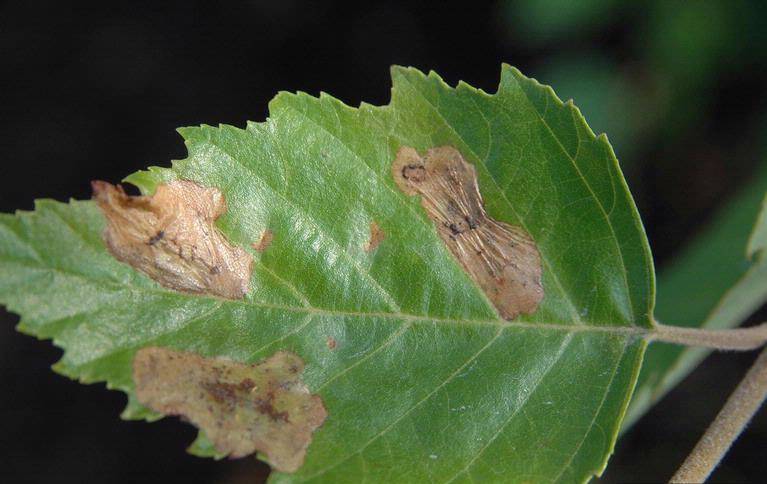Integrated Pest Management
Leafminers & Needleminers
 Leafminer damage (Brian Kunkle, University of Delaware, Bugwood.org)
Leafminer damage (Brian Kunkle, University of Delaware, Bugwood.org)
 Leafminer damage
Leafminer damage
HOSTS
- Deciduous trees (leafminers)
- Coniferous trees (needleminers)
DESCRIPTION
Leafminer and needleminers are typically the larval form of many insects that develop and feed of plant tissue underneath the surface of leaves and conifer needles.
BIOLOGY
Overwinter in the soil as pupae with adult flies emerging in the spring and summer. After mating, females use their ovipositor (egg-laying structure) to puncture the leaf surface to feed and lay eggs inside the leaf. Eggs hatch quickly when temperatures are warm, and the developing larvae create visible winding mines as they feed below the leaf surface. Larvae pupate within the mines, on the underside of the leaf, or more typically, in the soil. Adults emerge after about 10 days during the summer months, returning above ground to feed and lay eggs.
SYMPTOMS
- Larval feeding creates silvery-white blotches or tunneling in the leaf
- Mining may turn leaves brown and translucent
- Larval frass is typically present in the galleries
- Damage is an aesthetic issue, and rarely harms trees
GENERAL MANAGEMENT
To detect and monitor adults, look for new stippling on leaves which indicates the presence of adults. Yellow sticky cards can be placed at plant height (mid to lower portion) and inspected at least twice per week.
INSECTICIDES
The primary target of insecticides is the sap-feeding larva. Since larvae are protected within the leaf, insecticides that penetrate the leaf translaminarr activity) are most effective.
Chemical recommendations (by chemical class) for leafminer control in Utah:
- Abamectins: abamectin (Agri-Mek)
- Spinosyns: spinosad [Success, Entrust (organic)] and spinetoram (Radiant).
- Pyrethroids: gamma-cyhalothrin (Declare), lambda-cyhalothrin (Warrior), permethrin (Ambush, Pounce), pyrethrin Pyganicc (organic)]
- Neem: adadirachtinn Aza-Direct, Azatin (organic)]
- Insecticidal soap: M-Pede, Safer’s (organic)
- Oils: horticultural oil (many brands), plant oils (peppermint, rosemary) (organic)

